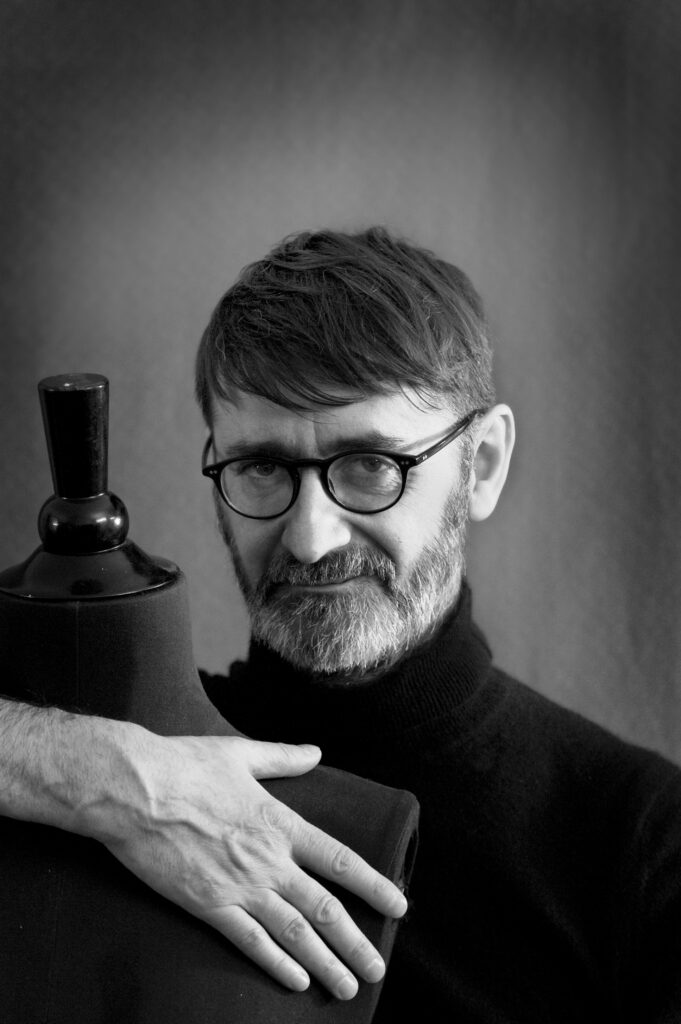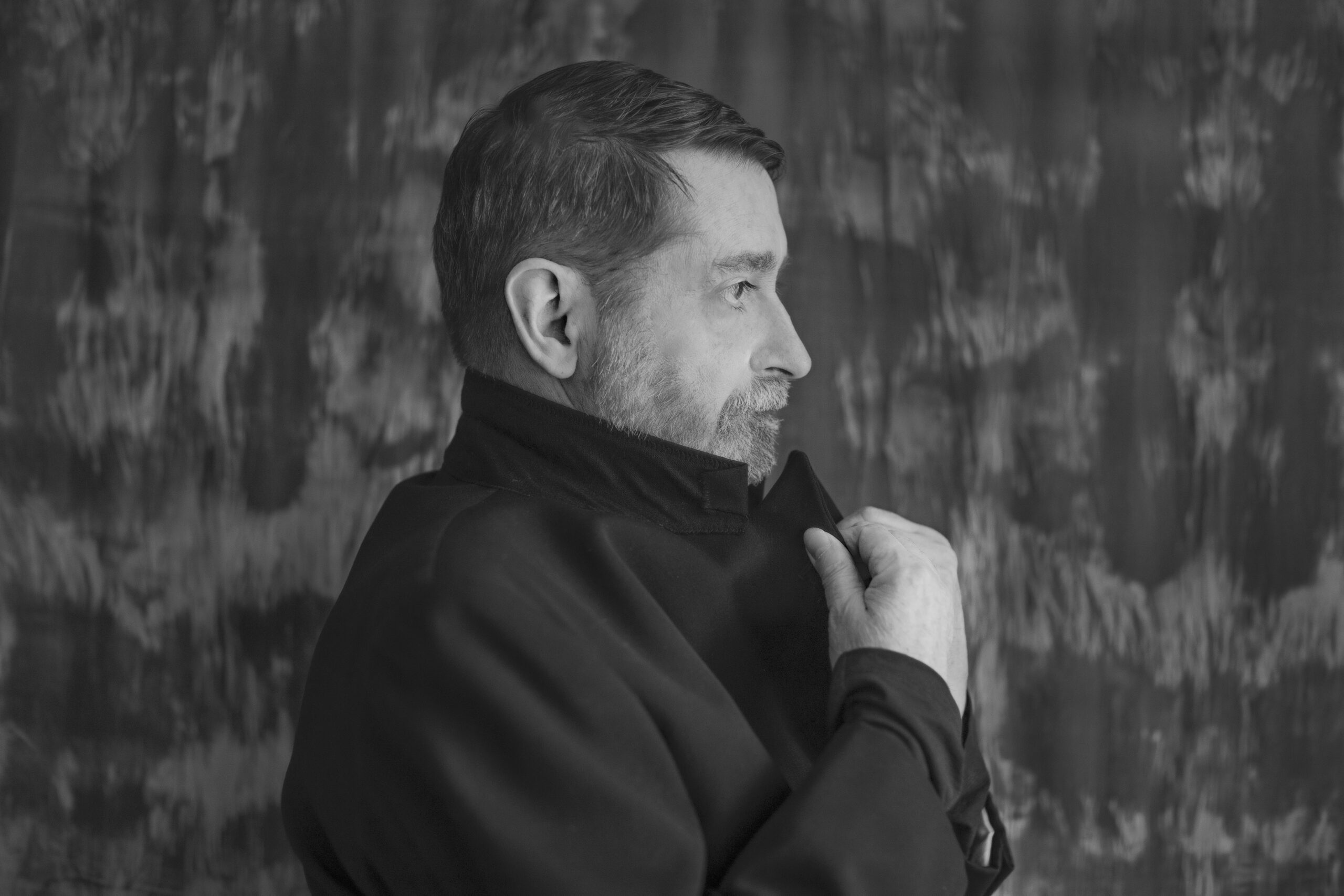Photo Credits: © GerardHarten
Franck Sorbier: The Last Master of Haute Couture Who Transforms Fashion into Art
At the heart of Haute Couture, where tradition and innovation collide with magnificence, emerges the incomparable figure of Franck Sorbier. With a career spanning over three decades, the French designer is one of the last Great Couturiers, a title he has not only earned but continuously redefines by blending artisanal craftsmanship with a unique artistic vision. From Paris to Tokyo, New York to Milan, his creations are more than mere garments — they are works of art that speak directly to the heart of global fashion and culture.
In an exclusive conversation, Sorbier reveals what inspires him, how he situates himself within the rich legacy of Haute Couture, and his vision for the future of creating, sewing, and transforming.
Haute Couture has always been a demanding universe, requiring constant passion and unwavering dedication. What uniquely fascinates you about this world, and what keeps the creative flame alive over the years?
FS: I am always in search of beauty and imaginary journeys. There are few passion-jobs that are as free and conducive to metamorphosis. I like to trace my own path, off the beaten track. I believe that the world of Haute Couture benefits from a range of excellences. The actors in this universe create a perpetual drive, characterized by cycles, it is also the spirit of time that defines the orientations.
What characterizes, however, Haute Couture is the spirit of continuity and the desire to maintain an extraordinary level of craftsmanship and artistry. Can we really explain a vocation? To tell the truth, in hindsight, I wouldn’t change anything about my risk-taking.

Photo Credits: © Jeff Guiot
Do you see yourself as a continuer of the legacy of masters such as Charles Frederick Worth and Paul Poiret, who laid the foundations of Haute Couture? What is your vision of your role within this rich tradition, and how does your work dialogue with the great names in fashion history?
FS: At that time, they were also innovative. For example, Paul Poiret freed women from the corset and Christian Dior brought it back into fashion after the war. I think that we are all heirs to those who came before us, the foundations of the profession are based on the transmission of know-how and the development of new techniques.
I don’t know if I have enough perspective to define my role, but I have the feeling that it is becoming clearer and clearer. I respect tradition and the timeless, but paradoxically I also like to play the troublemaker card, which gives my creations their contemporary aspect.
Your work is a masterful fusion of several art forms: from Haute Couture to interior decoration, jewelry creation, and even cinema. How does this interaction between different disciplines manifest itself? In what way do these worlds enrich your creative vision of fashion?
FS: Fashion is a societal phenomenon, as such, it is an integral part of the world around us. Fashion is a reflection of our times with the pros and cons that this entails. There is something totally subjective, that is where fashion draws its richness. Its diversity is its inexhaustible source. I have always thought that creatives were a kind of sponge capable of absorbing the multiple energies that surround them.
You were one of the first to integrate disruptive technologies into your presentations, such as augmented reality and 3D mapping. How do you see the role of technology in the evolution of Haute Couture? Do you think this union between fashion and innovation could rewrite the future of the industry?
FS: Technology offers many possibilities, but when it comes to sensitivity, the human being remains the guide. During my career, I have seen people working only on computers for patterns and who were completely cut off from basic techniques. They were helpless when it came to reading a drawing, interpreting it and bringing it to life in the form of a pattern or canvas.
Modern techniques cannot replace the talent and refinement of a workshop person. Technique, in all cases, is essential. But without taste and without talent, a technician will not go further … so a machine! Now, mastering these new tools can be a real contribution to future creation.
I believe more in technical means as an auxiliary to staging, to make eras collide or to ask fundamental questions that we will increasingly be confronted with, such as the distribution of roles between man and machine in our future societies.

Photo Credits: © Ilona Orel
What sets your work apart is your ability to preserve traditional artisanal sewing techniques while continuing to reinvent them. How do you balance the preservation of these ancestral practices with the need to innovate and push creative boundaries?
FS: This passion-job preserves, it is also the privilege of fashion in general. We do not feel the passage of time in the same way, this is what appears to me. The changes are not so brutal. The trends last, heavy industry has difficulty turning around. And then, fashion has finally become aware of its responsibilities and understood the challenges of tomorrow, fashion is no longer as versatile.
I believe that the important thing is to continue in its path, that it becomes more and more defined and stylized like a signature.
Beyond your incomparable contribution to fashion, you are firmly committed to humanitarian and cultural causes. How do your social actions and heritage preservation influence your creative practice? What can fashion offer the world in terms of social and humanitarian transformation?
FS: You are asking me a philosophical question. I do what seems right and important to me at the time I do it. Clothes are a medium to express ideas, positions to raise questions. Committed collections are often the most rewarding. Fashion has many cards to play, it is only just beginning to open its eyes.
Being the second most polluting industry in the world, the clothing sector has a real responsibility, luxury too. We are lucky to live in a creative country, creation is an excellent vector of information, education and training too. Why deprive ourselves of it? Everyone is sensitive to creativity, fashion exhibitions are popular. Perhaps because today, it is presented in a different and more perceptible way.
Your collections are described as a true homage to the sophistication and poetry of Haute Couture. What do you want the audience to feel when observing or wearing your creations? What is the essential message you seek to convey, not only through design but also through your unique presentations?
FS: Emotion remains the most important feeling for me. When I attended the first fashion shows in the early 80s, there was a fever, an enthusiasm… like something electric in the air. Haute Couture, despite over-mediatization, remains a world apart.
I also think that we will return to a more delicate atmosphere, to more confidential moments. For me, Haute Couture presentations must leave a memory and an indelible mark. As for the clothes, I like the people who wear them to make them their own. And then, a couturier proposes, the clients dispose. That is the essence of Haute Couture.
In an era where fashion is experiencing a digital and global revolution, what is your perspective on the role of Haute Couture in contemporary fashion culture? What is the importance of your legacy not only for Paris but for global fashion, and what footprint do you wish to leave for future generations of designers and artisans?
FS: Haute Couture should cultivate its difference more: it must be perceived as the sanctuary of fashion. It is also a significant force for communication and an image of excellence. Once reserved for clients and a few celebrities, Haute Couture has become more democratic, there is no longer any distinction between Haute Couture and so-called luxury ready-to-wear.
There is a lot of confusion, it is perhaps the symptom of our contemporary culture, it is searching for itself and exploring all possibilities. This is where innovation can help us sort things out to become more purist while remaining open to evolution and its changes.
As for my legacy, I hope to have a few more years to perfect it. In any case, some professionals are better placed than me to debate it. I think that humanism will become a crucial point in tomorrow’s society and I cultivate this philosophy through my work, since my beginnings.
You invented the textile Compression©, which has become your signature. How did this innovation come about, and how did it influence your creative freedom in Haute Couture?
FS: By inventing the textile Compression©, which has become my own signature (the Compression©, which Franck Sorbier alone masters; registered technique and owner of the brand), I got closer to sculpture and therefore, more to art.
Fashion is an applied art and it has often been inspired by great artistic movements. When I started in Haute Couture, in July 1999 as a guest member of the Chambre Syndicale de la Couture parisienne (today called the Fédération Française de la Couture et de la Mode – FHCM), I approached things in a totally instinctive way. I needed a new lease of life and it was my passion for the sewing machine that accompanied me in this new research.
I have never felt so free, there was no more reference to the past or nostalgia of any kind. The field was virgin and the possibilities unlimited. In the 90s, as designer of luxury ready-to-wear, I was seen as the “artisan poet”. In Haute Couture, I felt like I was going even further… and being even closer to who I am.
The title of Maître d’Art, which was awarded to you by the French Ministry of Culture, is a recognition of your mastery and dedication to the art of fashion. What does this title mean to you, and how does it reflect your vision for the future of Haute Couture in an ever-changing world?
FS – What touches me most about this title, this distinction is that I am the only Grand Couturier, to this day, in the fashion and luxury industry, who owns this label. That Mr. François Lesage and Mr. Raymond Massaro, my elders were, and that all those who own this title are craftsmen, as varied as master glassmakers, cabinetmakers, stone cutters, goldsmiths… and many other demanding and ancestral disciplines. There is nobility in this recognition.
This title lives as long as there are fighters. This is also why transmission, which is at the heart of this subject, remains the nerve of war because it is about defending a certain vision of what humanity is and its heritage.
Franck Sorbier’s career is a testament to his exceptional mastery of Haute Couture, blending tradition with contemporary innovation. His unwavering commitment to the craft has not only elevated his personal journey but has also contributed significantly to the continued evolution of Haute Couture in an ever-changing world.
Through his artistry, Sorbier has redefined the boundaries of fashion, ensuring that it remains both a timeless and forward-thinking discipline. His profound influence on the industry continues to shape its future, leaving an indelible mark on the global fashion landscape.

